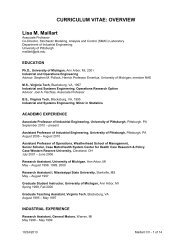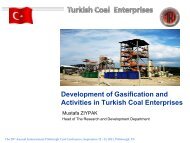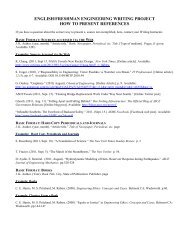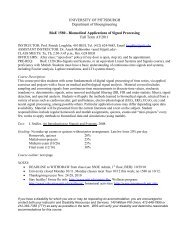Abstract Booklet 2006 - Swanson School of Engineering - University ...
Abstract Booklet 2006 - Swanson School of Engineering - University ...
Abstract Booklet 2006 - Swanson School of Engineering - University ...
Create successful ePaper yourself
Turn your PDF publications into a flip-book with our unique Google optimized e-Paper software.
13-1<br />
SESSION 13<br />
GASIFICATION TECHNOLOGIES:<br />
APPLICATIONS AND ECONOMICS – 3<br />
GE and Bechtel’s IGCC Reference Plant Update<br />
Rich Rapagnani, GE Energy, USA<br />
For background, GE Energy purchased ChevronTexaco's gasification technology business in<br />
June <strong>of</strong> 2004, and soon thereafter formed an IGCC alliance with Bechtel Corporation to<br />
jointly develop and commercialize an IGCC reference plant. Rated nominally at 630 MW,<br />
this IGCC Reference Plant provides customers a commercially competitive, cleaner coal<br />
alternative for coal to power. Moreover, the GE and Bechtel IGCC Alliance provides this<br />
IGCC product on a turnkey basis, including commercial guarantees, thus <strong>of</strong>fering the total<br />
package customers need for successful commercialization <strong>of</strong> their project.<br />
This presentation provides to the conference attendees an update on the GE and Bechtel<br />
IGCC Reference Plant design status, a look at the fuel flexibility benefits inherent in such a<br />
plant design, a preview <strong>of</strong> the expanded fuel envelope capabilities under development by GE<br />
and a discussion <strong>of</strong> the business aspects supporting development <strong>of</strong> IGCC projects.<br />
13-2<br />
Beluga Coal Gasification Feasibility Study Phase 1<br />
Ronald Sch<strong>of</strong>f, Robert Chaney, RDS-Parsons Corporation, USA<br />
The Beluga Coal Gasification study aims to determine the economic feasibility <strong>of</strong> siting a<br />
coal-based gasification plant in the Cook Inlet region <strong>of</strong> Alaska for the co-production <strong>of</strong><br />
electric power and marketable by-products. The plant products may include synthesis gas,<br />
Fischer-Tropsch (F-T) liquids, fertilizers such as ammonia and urea, alcohols, hydrogen,<br />
nitrogen and carbon dioxide, that would be manufactured for local use or for sale in domestic<br />
and foreign markets. The project was divided into two phases. In Phase 1, the Agrium<br />
fertilizer plant in Nikiski serves as the case study site and customer for product gases<br />
(including hydrogen, nitrogen and carbon dioxide), steam and power from the coal<br />
gasification facility. In Phase 2, an assessment <strong>of</strong> alternative locations and plant designs<br />
based on local and export markets for the suite <strong>of</strong> potential products will take place. The<br />
Phase 1 case study results, reported here, will feed into the Phase 2 central Alaska regional<br />
study. The project may be broken into four major subject areas, described below:<br />
Gasification Plant Design: The coal gasification plant investigated in this study is designed<br />
to provide the Kenai Nitrogen Operations (KNO) plant with the following suite <strong>of</strong> required<br />
products:<br />
• 282 million standard cubic feet per day (MMSCFD) <strong>of</strong> hydrogen at 400 psig and <strong>of</strong><br />
suitable quality for ammonia production.<br />
• Stoichiometric quantity <strong>of</strong> nitrogen (approximately 100 MMSCFD) at 400 psig and<br />
99.99% purity.<br />
• 1,500,000 lb/hr steam at 1500 psig and a minimum temperature <strong>of</strong> 825°F.<br />
• 300,000 lb/hr steam at 600 psig and 625°F.<br />
• 2,500 tpd CO 2 suitable for urea production (25 psig)<br />
• Electric power to satisfy the auxiliary power requirements for the gasification plant<br />
and the KNO facility, to make the entire facility electric power independent.<br />
Two cases were considered:<br />
Case 1: Process the syngas from the gasification plant to supply required hydrogen and<br />
nitrogen to the KNO ammonia synthesis loop compressor and produce sufficient steam and<br />
power for the KNO needs. Capital Cost was $1.64 billion.<br />
Case 2: Process the syngas from the gasification plant to supply required hydrogen and<br />
nitrogen to the KNO ammonia synthesis loop compressor, but do not produce power from a<br />
gas turbine. Rather, independently produce the required steam and power for the KNO<br />
facility with a CFB coal-fired boiler. Capital Cost was $1.87 billion.<br />
Financial Analysis - The Power Systems Financial Model Version 5.0 (now the standard<br />
used by NETL for IGCC systems analysis) was used to perform the financial analysis.<br />
Factors in the analysis included: coal and limestone supply and cost, by-product markets,<br />
and impact on local natural gas and electric power markets. Project return on equity<br />
investment (ROI) and a discounted cash flow analysis were key results. Identification <strong>of</strong> key<br />
model sensitivities also occurred.<br />
Case 1 possesses superior financial potential relative to Case 2. For Case 1, the ROI was<br />
11.1% with a Payback Year <strong>of</strong> 2023, assuming start-up in 2011. For Case 2, the ROI was<br />
6.0% with a Payback Year <strong>of</strong> 2031. While both cases produce enough raw materials<br />
necessary for ammonia and urea production at the Agrium facility, Case 2 is more<br />
expensive, produces less export power, and requires slightly more coal feed in order to do so.<br />
Sensitivity analysis was performed on all model inputs in both cases. The items found to<br />
have the greatest impact on the financial results are the plant EPC cost, system availability,<br />
ammonia/urea prices, and coal price.<br />
Environmental Issues The analysis <strong>of</strong> the design basis indicates that a proposed IGCC<br />
facility at the Agrium Kenai Plant is feasible in terms <strong>of</strong> current environmental permitting<br />
and compliance requirements imposed by federal, state and local regulations.<br />
Carbon Capture/Use - The potential for use <strong>of</strong> CO 2 for enhanced oil recovery in regional oil<br />
fields was a major consideration. It was determined that CO 2 floods could economically<br />
produce up to 300 million barrels <strong>of</strong> oil in Cook Inlet fields with oil prices at $35 to $40/bbl<br />
and CO 2 price at from $0.50 to $1.20/mcf. The production potential is equal to that achieved<br />
locally over the last 25 years by conventional methods.<br />
13-3<br />
<strong>2006</strong> Cost and Performance Estimates <strong>of</strong> Fossil Energy Power Plants<br />
Jared P. Ciferno, RDS-Parsons Corporation, USA<br />
Julianne Klara, NETL, USA<br />
In 1999, the Department <strong>of</strong> Energy s National Energy Technology Center (NETL)<br />
sponsored a report entitled Market-Based Advanced Coal Power Systems in response to a<br />
newly deregulated power industry. The study, conducted by Parsons Corporation, compared<br />
the performance and economics <strong>of</strong> power systems that were advanced, yet market-ready<br />
within a 5 year time frame that included Pulverized Coal Boiler (PC), Natural Gas<br />
Combined Cycle (NGCC), Integrated Gasification Combined Cycle (IGCC) and 2nd<br />
Generation Pressurized Fluidized Bed Combustion (PFBC) power plants. In the 7 years<br />
since this report was published, natural gas prices have more than doubled while proposed<br />
emissions regulations such as EPA s Clean Air Interstate Rule (CAIR) and the Proposed<br />
Power Plant Mercury Rule, have forced the potential inclusion <strong>of</strong> control devices and<br />
operational strategies to lower future power plant emissions. Furthermore, concern over the<br />
potential effect <strong>of</strong> CO 2 emissions from fossil fuel power plants on the global climate is a key<br />
issue for the future <strong>of</strong> power generation worldwide. With energy demand projected to rise by<br />
over 60% through 2030, limiting CO 2 emissions from power plants is becoming ever more<br />
pressing. Finally, technological advances such as the anticipated introduction <strong>of</strong> a synthesis<br />
gas fired gas turbine and expected improvements in the operation <strong>of</strong> gasifiers will affect the<br />
overall plant performance. As a result <strong>of</strong> changing economic, regulatory and technological<br />
issues, the 1999 study has become outdated. The effort that is currently underway is the <strong>2006</strong><br />
Market-Based Advanced Coal Power Systems study, expanded to include three competitive<br />
gasifier technologies, with and without CO 2 capture. Economic issues, including the rapid<br />
increase in natural gas prices and the shift in the industry back to coal-based plants, are<br />
considered here. Pollution control technology advances, brought about by anticipated<br />
regulation, result in cleaner plants. Advances in gas turbine, gasifier and other balance <strong>of</strong><br />
plant equipment are taken into account. Cost and performance results <strong>of</strong> the study effort will<br />
be discussed in this paper and at the conference presentation.<br />
13-4<br />
Advanced Clean Coal Technologies for Capture<br />
Minish Shah, Praxair, Inc., USA<br />
In the absence <strong>of</strong> any regulations on CO 2 emissions in the US, the focus is on building new<br />
power plants that are CO 2 capture ready. This paper compares and contrasts two advanced<br />
clean coal technologies for CO 2 capture: Integrated Gasification Combined Cycle and Oxy-<br />
Coal Fired Boiler. The gasification has been widely promoted and the oxy-fuel combustion<br />
is also gaining support as a viable alternative for CO 2 capture. Both <strong>of</strong> these technologies are<br />
touted for their potential to capture CO 2 at low cost. There are significant differences in the<br />
commercial readiness and the CO 2 capture readiness. These issues will be highlighted and<br />
the cost and performance with CO 2 capture will be presented for both the technologies. All<br />
the individual components <strong>of</strong> IGCC plant with CO 2 capture have been demonstrated in large<br />
scale operation in different applications. The main obstacles to commercialization <strong>of</strong> IGCC<br />
are uncertainties related to costs and reliability. Adding CO 2 capture capability to IGCC will<br />
impact the performance <strong>of</strong> all the major sub-units (gasification, combined cycle and ASU).<br />
Therefore, to make IGCC CO 2 capture ready, significant preplanning will be required. The<br />
oxy-fuel technology allows utilities to build power plants based on air-fired PC boiler,<br />
technology they are most familiar with and one which requires lower initial investment<br />
compared to IGCC. And for CO 2 capture, two new sub-systems (an air separation unit and a<br />
CO 2 clean-up unit) can be installed only when needed further minimizing up-front<br />
investment. However, there has been no large-scale demonstration <strong>of</strong> some <strong>of</strong> the subcomponents<br />
<strong>of</strong> this technology. Although in theory, the oxy-coal fired boiler can be operated<br />
to mimic the air-coal fired boiler, testing at smaller scale will be necessary to understand<br />
flame and heat transfer characteristics and materials compatibility due to different chemical<br />
environment within the boiler. The learnings from such testing will also be needed to<br />
establish whether any design changes are required for the CO 2 -capture ready plant. The CO 2<br />
clean-up will also require further development to address issues related to impurities such as<br />
SO x and NO x .<br />
13-5<br />
Power Systems Development Facility Update on Six Trig Studies<br />
Luke H. Rogers, Southern Company Services, USA<br />
George S. Booras, Electrical Power Research Institute, USA<br />
Ronald W. Breault, National Energy Technology Center, USA<br />
Nicola Salazar, Kellogg Brown and Root, Inc., USA<br />
The pursuit <strong>of</strong> more cost-effective and reliable coal technologies with superior<br />
environmental performance continues to drive the development <strong>of</strong> the Transport Gasifier at<br />
the Power Systems Development Facility (PSDF). This paper presents the results <strong>of</strong> six<br />
updated system and economic studies <strong>of</strong> Transport Integrated Gasification (TrIG) plants.<br />
Southern Company and Kellogg Brown and Root (KBR), in conjunction with the U.S.<br />
Department <strong>of</strong> Energy (DOE) and other partners, are developing the TrIG process at the<br />
PSDF for commercial application in the power industry. The PSDF is an engineering scale<br />
demonstration <strong>of</strong> the KBR Transport Gasifier along with a high-temperature, high-pressure<br />
11














